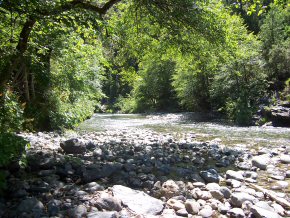Home on the River
April 5, 2011
By Dave Lambert
Imagine if you will, a green carpet of tall trees extending inland from the Pacific Coast to the Seiad Valley. Scattered here and there are natural meadows and lush grasslands where herds of elk and deer graze peacefully. This pristine wilderness abounded with wildlife of many kinds, Grizzlies, cougar, wolves, wolverine., lynx, black bear and many others co-existed here.
Winding through this paradise is an emerald green river of volcanic origin, which is teeming with life. Salmon, sturgeon, steelhead, eel’s shad and suckers all ascend this powerful waterway to spawn and replenish their species. Eagles, ospreys, ducks, otters and mink all proliferated along it shores. This is the river Klamath!
Originating in eastern Oregon, it flows south into upper and lower Klamath Lakes where the Klamath Tribe lives, whom the river is named after. It then flows southwest for several hundred miles where it merges with the Trinity River. From there it swings due west and continues on to tend the long, winding journey by emptying in to the Pacific Ocean.
The native peoples who called this paradise home had lived in harmony with nature for hundreds of years. They had never heard a loud, unnatural sound, such as a gunshot, the ruble of a jet passing overhead or the roar of a combustible engine. Pollution as we know it was unknown.
Life was not exactly effortless but all necessities could be secured without undue hardship. It seemed to them that the Great Spirit had smiled upon this land of the river called Klamath.
There is some evidence of foreigners cohabiting with Indians long before the coming of the miners. It is known that trappers and traders were here by the turn of the 18th century because of the abundant beaver, mink, muskrat, bobcat and many other fur bearing animals. When this fur trade was at its peak this was the disputed territory of several fur trading companies. In 1850, when gold was discovered in the ancient alluvial gravel deposits along the river, life quickly changed for all the inhabitants of the area. With the gold seekers came progress and the inevitable taming of the area. The U.S, Government was eager to add the freshly mined gold to its treasury and the miners no time to exploiting to the extreme. Claims were staked on every patch of high bar and gravel deposit that could be found. There were the natural flats and benches along the stream bank that just so happened to be where the village sites were also located. The rich layer of topsoil was the first to get washed down through the sluice boxes. This was followed by the gold bearing gravel and boulders and eventually to bedrock where the much hoped for giant nuggets would be found.
Chinese miners began arriving and as they had previous experience at mining were very successful in procuring the gold they had come





